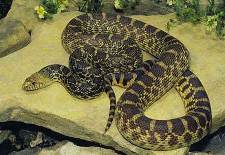The Bullsnake (Pituophis catenifer), also referred to as a Gopher snake or Pine snake, is the most common snake found outside of urbanized areas across the state of Nebraska. The coloration of a Bullsnake varies tremendously. It may be brown with almost black blotches to a yellowish cream background with light tan blotches. The Bullsnake usually has 41-60 blotches extending down its length that become bands on the tail. At the end of the tail it has a single small pointed scale that resembles a prebutton of a rattlesnake tail; however there is no close relation between Bullsnakes and rattlesnakes -they are two distinct species with different chromosomes numbers that could never cross and reproduce.
A Bullsnake can be identified by the black line from the eye to the angle of the mouth and its pointed nose. The Bullsnake is the only species in Nebraska that has a streamlined spear -shaped head with a pointed nose for burrowing after prey such as moles and gophers - in fact, it has an extra thick scale on the tip of its snout. Most other snakes in the state are not capable of burrowing and instead use the burrows of other animals.
The Bullsnake is Nebraska's largest native snake species, reaching lengths over eight feet. Known as the "farmer's friend," an adult Bullsnake can easily feed on a dozen mice, pocket gophers, or small rabbits each week. This species is one of the state's most robust snakes, able to successfully consume natural prey up to a pound. The majority of other snakes in Nebraska feed on much smaller animals. Bullsnakes are excellent predators and commonly outcompete other snakes in a given location. This superior competition has led some people to mistakenly think Bullsnakes will eat or chase rattlesnakes out of an area.
Bullsnakes adjust and adapt to the habitat alteration and are commonly encountered around acreages, farms, and urban parks. When approached, a Bullsnake exhibits one of the most impressive defensive displays. It will hiss loudly, rattleits tail, flatten its head, and strike, respectively. They pose no harm to people, however.
Bullsnakes prefer to prey on rodents but also will feed on birds and eggs. It is not uncommon for a Bullsnake to climb the interior of a barn or shed wall to feed on all the baby Barn swallows in a roofline nest. While they may steal eggs from a hen house, they will eliminate egg-eating weasels, minks, and rats from the same location.

